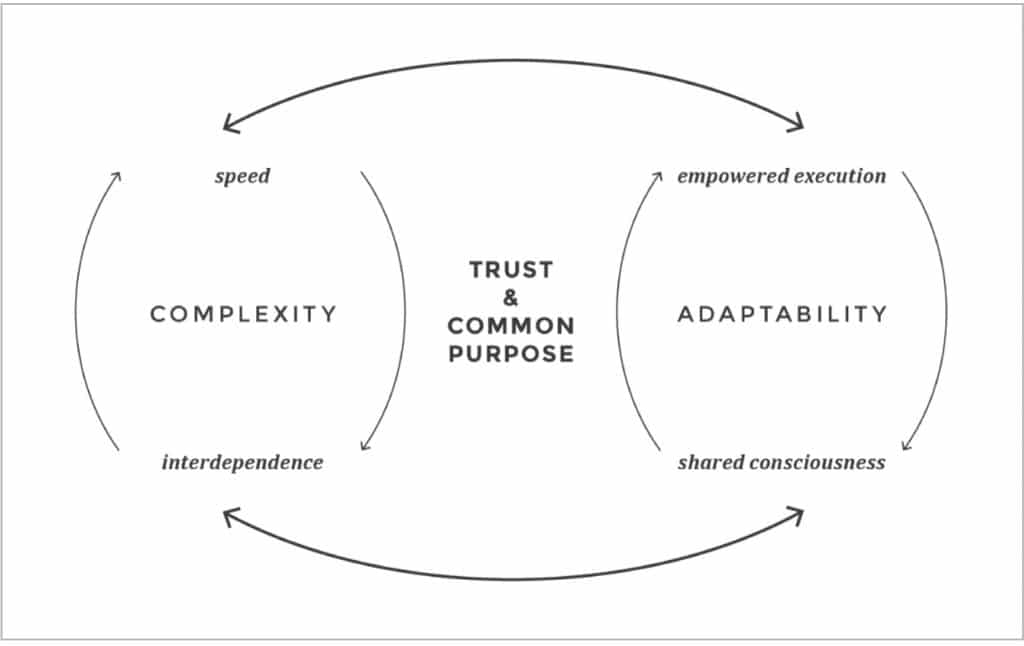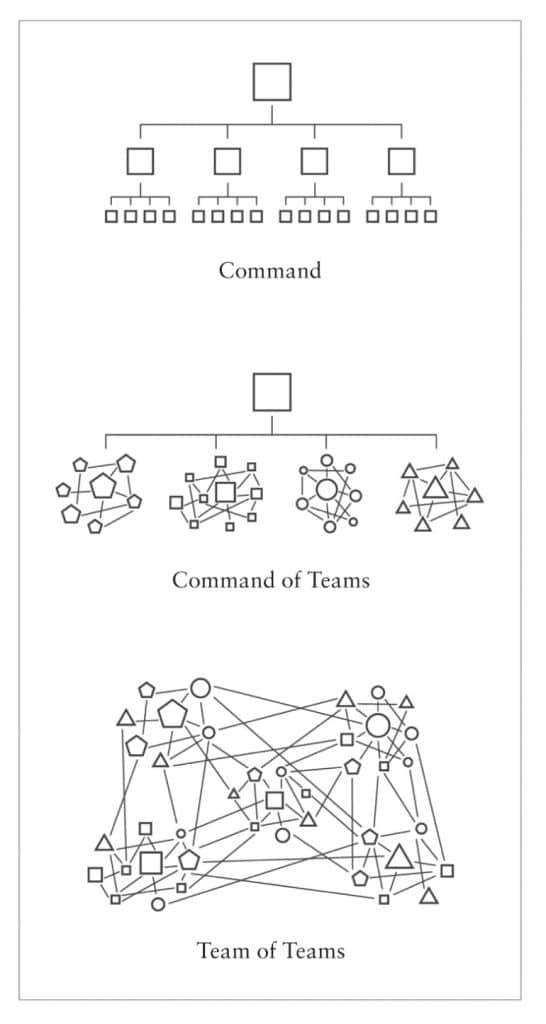Genre: Management
By
Hardcover | 304 pp. | Portfolio | 12/05/2015 | 1st Edition
Buy on Amazon
Team of Teams is a book that is built with the army’s rigour. Written by former US Army General Stanley McChrystal together with Tantum Collins, David Silverman and Chriss Fussell. The narrative is well constructed, and a few sections seem to be taken out of a Hollywood action movie. Its actual value, however, lies in the step by step demolition of traditional organisational habits on which the army is usually known: a hierarchical structure, ranks, strict command and control rules, tight segregation of information, secrecy, strategy and tactics. Many of the words we use have a specific significance in a military context, and we seem to immediately connect them to an immutable way of working of the military that directly descends from history and the work of the Prussian empire.
This book tells a different story instead: that of a different war, where the opponent was not an organised army, but a terrorist network. Al-Qaida in Iraq (AQI) was a much foreign enemy then any other met before. Other terrorist organisation back had adopted organisational structures that were difficult to map. But in this case, the difference was given by the usage of technology, which would provide immediacy to several possible activities else impossible to coordinate. The entire organisation acted as a flexible network, impossible to fight with the weaponry of a traditional organisation.
Although lavishly resourced and exquisitely trained, we found ourselves losing to an enemy that, by traditional calculus, we should have dominated.
Gen. Stanley McChrystal et al., Team of Teams, page 2
The parallel with current market scenarios for many organisation is exact. A lot of the suggestions of Team of Teams are even more applicable in the present system, disrupted by the pandemic. The reality of the VUCA world hit hard. Realising that the military knew about this situation, but still could not fully understand its consequences, was daunting. “For a soldier trained at West Point as an engineer, the idea that a problem has different solutions on different days was fundamentally disturbing. “
The Wrong Pursuit for Efficiency
The pursuit of “efficiency”—getting the most with the least investment of energy, time, or money—was once a laudable goal, but being effective in today’s world is less a question of optimizing for a known (and relatively stable) set of variables than responsiveness to a constantly shifting environment. Adaptability, not efficiency, must become our central competency.
Gen. Stanley McChrystal et al., Team of Teams, page 19
The biggest realisation is that organisations built for efficiency are more fragile in the current environment. They are built on assumptions of predictability that does not exist, of leadership models that are not replicable, of control mechanisms that are disappearing. The reality hits hard when generals are trained to win the last war, and not the current one.
For example, when facing a terrorist organisation, the risk is to succumb to the “great man theory” and attribute all the successes to one man. But the reality is that Al-Qaeda had demonstrated its ability to resurge also when top men in this organisation were arrested or eliminated. Not only did they have no standard modus operandi, they had no standard hierarchy.
The problem with efficiency is that in too many cases, we assume that an organisational choice that worked can be copied and repeated across other units or other organisations. “But an organisation’s fitness—like that of an organism—cannot be assessed in a vacuum; it is a product of compatibility with the surrounding environment. “
What’s interesting about the book is that it narrates a few examples from military history, that all testify how important it is to disrupt paradigms, focus on individual initiative rather than pure execution of commands and think “laterally”. The victory of Nelson against Napoleon’s fleet is a prime example of this – at the heart of his success was patient, yet relentless, nurturing of competence and adaptability within his crews.
Adaptability, not efficiency becomes the key feature that organisations should be striving for.
Moving Away from Reductionism
Chapter two analyses at length the work of Taylor and the consequences of the idea of Scientific Management. His idea of building a “workplace ruled by science” matched the concept of a “clockwork universe” that also dominated the scientific narrative at that time. Taylor’s success in his factories represented the legitimisation of “management” as a discipline.
The effects of this have been visible for decades in the army’s organisation. A “never again” mentality developed, that tried to base future forecasts on “lessons learned”, driven by efficiency. The example of the Maginot Line is striking. Built by the French to prevent an attack by Germans similar to what had happened during World War I, the impenetrable but immovable defence line could not do much towards an enemy that blazed around in a flanking manoeuvre.
Scientific Management and its Reductionism have created an Army with the proverbial general always fighting the last war. Reductionism can be applied successfully to complicated processes that can be broken down into units but cannot reduce complexity. Predictability, once a pillar of management theory, is simply unattainable in the current situation. And also recent focus on big data and analytics can be misleading. “Data-rich records can be excellent for explaining how complex phenomena happened and how they might happen, but they can’t tell us when and where they will happen.“
Gaining understanding is not always the same as predicting.
Gen. Stanley McChrystal et al., Team of Teams, page 72
Building Resilience
Resilience becomes the second key element in the development of an organisation that can survive a complex ecosystem.
In complex environments, resilience often spells success, while even the most brilliantly engineered fixed solutions are often insufficient or counterproductive.
Gen. Stanley McChrystal et al., Team of Teams, page 76
The key for the transformation is in shifting our focus from predicting to reconfiguring. It’s moving away from the idea of doing things right and moving in doing the right things. Effectiveness is paramount. But traditional management systems tend to be efficient, not adaptable. The transition to this concept is the focus of the second part of the book.
Teams are the nucleus around which experimentation takes place. The core idea is to move from command to teams, also exploiting successful experiences in the military itself. The book goes at a great length, for example, in describing how SEAL teams are formed, underlining the positive experience here as well.
The one great learning about Teams is that Team members tackling complex environments must all grasp the team’s situation and overarching purpose. An essential move away from the reductionist principle of Taylorism.
Purpose affirms trust, trust affirms purpose, and together they forge individuals into a working team.
Gen. Stanley McChrystal et al., Team of Teams, page 99
Through several descriptions of concrete cases, also spanning outside the military realm, Team of Teams builds a strong argument in support of the case for building teams. Trust, purpose are the key pillars for success, as well as their “multi-disciplinary” approach, and the transparency needed. In some of the instances, teams win not because of the precise plans, but rather because of the structure itself of the team. Emergence becomes another foundational element in the discussion because teams can build order bottom-up, keeping flexibility and adaptability at their core.
Building Successful Teams
It is exciting to note the sheer amount of examples that the book produces, already from the sixties and seventies. Environmental challenges that we today define as VUCA are not new. Mission Critical Teams have been built for decades, reflecting the increasing complexity of the world—or rather, the tactical understanding that responding to such a world requires greater adaptability, and adaptability is more characteristic of small interactive teams than large top-down hierarchies.
The MECE concept that, according to the authors, is a core of consulting work, is among the culprits for the absence of adaptability. Ordering functions, departments, processes into “Mutually Exclusive and Collectively Exhaustive” clusters is a tidy, effective way to organise categories. But it is not always an effective way to organise people. In traditional organisations often teams sit across the organisation chart and challenge the MECE thinking. Though teams have proliferated across organisations from hospitals to airline crews, almost without exception, this has happened within the confines of broader reductionist structures, and this has limited their adaptive potential. A team leader still needed to report into an organisation area, the funding required to be requested and so on. Problems existed on the fault lines—in the spaces between elite teams.
Teams work well because they are small: people know each other intimately and work together for much time. Yet, the size is also consistently the limit of many team experiments.
the very traits that make teams great can often work to prevent their coherence into a broader whole.
Gen. Stanley McChrystal et al., Team of Teams, page 125
The authors look at some visible dysfunctions of teams in broader organisations. Tribal Competitiveness is the first one examined. Scaling purpose and team targets is not easy, and often competitions start even if triggered by belonging. Size is a linked collated issue: growing a team leads to the dismantling of the features that make the team great.
The only possible answer that the authors see is that of creating a team of teams.
on a team of teams, every individual does not have to have a relationship with every other individual; instead, the relationships between the constituent teams need to resemble those between individuals on a given team:
Gen. Stanley McChrystal et al., Team of Teams, page 128
It is precisely this realisation that is at the core of the book, as it introduces a new way of looking at “team of teams”, where the critical sharing concepts of a team are scaled to more extensive organisational settings.
Transparency and Sharing
The capability to positively share information is the one element that emerges clearly. Specialisation in specific domains brought much depth in knowledge, but often people lacked breadth they needed to understand a situation. The military has been marked by operating on a “Need To Know” basis for long, as many other organisations do as well. For sure information constraining has a lot to do with security concerns, but this made also accessing information an issue when being fast is vital.
Functioning safely in an interdependent environment requires that every team possess a holistic understanding of the interaction between all the moving parts.
Gen. Stanley McChrystal et al., Team of Teams, page 140
System Thinking becomes crucial, as the capability to understand the bigger picture and correlate different types of information and multiple sources. Not as a feature exclusively of leaders, but of all the members of the team, as they all have ton continuously integrate different parts of information and work.: “in a domain characterised by interdependence and unknowns, contextual understanding is key; whatever efficiency is gained through silos is outweighed by the costs of “interface failures.”.
cognitive “oneness”—the emergent intelligence—that we have studied in small teams can be achieved in larger organizations, if such organizations are willing to commit to the disciplined, deliberate sharing of information. This runs counter to the standard “need-to-know” mind-set.
Gen. Stanley McChrystal et al., Team of Teams, page 150
Seems almost natural if we think about it: after all what makes a small team work is the transparency and trust in it. Yet this basic concept requires unlearning of fundamentalist approaches to efficiency and its implementation requires constant maintenance: making sure that everyone has continuously updated, holistic awareness became a full-time job for many, and necessary time and commitment from everyone.
An interesting take on the “fundamentalist approaches to efficiency” is the examination of the way management has designed physical spaces for white collars: offices designed to maximise productivity and control. Teamwork requires different perspectives, also applied to the office space (or any space for that matter, as it becomes more apparent that work cannot be confined to a physical area alone), which needs to be designed having flexibility and integration in mind.
By implementing these changes, creating a dedicated Team of Teams where the different entities of the US government could work together, meant that better results where achieved on the ground. Our organisation was not just “getting smarter” or “doing more” in isolation. Instead, it was acting smarter and learning constantly, simultaneously.
Contrary to what traditional management theory advised, which was do have decentralised operations with coordinated control, the authors found that they needed the opposite.
we needed coordinated operations, something that necessitated emergent, adaptive intelligence. Shared consciousness achieved this, but it was only the first half. As we would soon find, keeping pace with the speed of our environment and enemy would require something else as well: decentralized control.
Gen. Stanley McChrystal et al., Team of Teams, page 198
Leadership style was here key, in allowing the above to happen because decentralising control meant allowing decisions to be flown by the people who had the information—an element we have seen recently advocated also by Reed Hastings at Netflix.
Leading becomes then similar to what a gardener does: nurturing the terrain to grow the plants. In the teams’ context, the proper nurturing aspect becomes creating a shared consciousness, as this enables good decision making at all levels.
Conclusion

The above image summarises the fundamental concepts of the book Team of Teams. We are in a world where speed and interdependence are creating more and more complexity. The only way to react is to ensure that our organisations develop adaptability, and this is only achievable if teams can couple shared consciousness and empowered execution. Trust and Common Purpose allow for drive and alignment.
The book builds a thorough case for scaling the correct elements of teams into a larger organisation. By refuting the idea that command and control structures need to exists, and positioning organisational structures as relative to the context, this book gives strong support to the understanding of why more human-centric organisation models need to live.
Yet, it demonstrates once more how a certain level of visionary, if not charismatic leadership is necessary to trigger the change.
At the same time, the model proposed speaks of empowerment rather than genuine autonomy, illustrating still a residual catch of traditional control. Team of Teams is a highly influential book, also because of its solid background of practice. Seeing the army in a different light can also help us shed our language from some militaristic wordings. In a moment of high volatility such as the one posed by Covid, the book has been illuminating ion some of the logical connections and the critiques to the traditional models, which deserves it a place among my Rebels at Work list of Books.
Did you read the book? How did you find it? Why not add a comment?

Genre: Management | Rating: 4.5/5
Hardcover | 304 pp. | Portfolio | 12/05/2015 | 1st Edition
ISBN: 9781591847489
Buy on Amazon


[…] Book Review: Team of Teams by Gen. Stanley McChrystal […]
[…] Read the full reviewBuy on Amazon […]
[…] will make an example to be clear. A terrorist unit such as those from Al-Qaeda that is described in A Team’s Team, all have a purpose. And this purpose provides the members of the cell a strong bond (that’s what […]